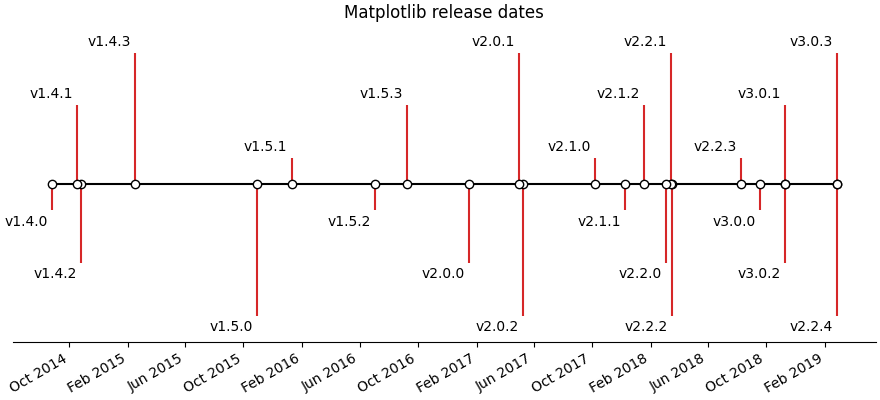笔记
单击此处 下载完整的示例代码
创建包含线条、日期和文本的时间线#
如何使用 Matplotlib 发布日期创建简单的时间线。
可以使用日期和文本的集合创建时间线。在这个例子中,我们展示了如何使用最近发布的 Matplotlib 的日期创建一个简单的时间线。首先,我们将从 GitHub 中提取数据。
import matplotlib.pyplot as plt
import numpy as np
import matplotlib.dates as mdates
from datetime import datetime
try:
# Try to fetch a list of Matplotlib releases and their dates
# from https://api.github.com/repos/matplotlib/matplotlib/releases
import urllib.request
import json
url = 'https://api.github.com/repos/matplotlib/matplotlib/releases'
url += '?per_page=100'
data = json.loads(urllib.request.urlopen(url, timeout=.4).read().decode())
dates = []
names = []
for item in data:
if 'rc' not in item['tag_name'] and 'b' not in item['tag_name']:
dates.append(item['published_at'].split("T")[0])
names.append(item['tag_name'])
# Convert date strings (e.g. 2014-10-18) to datetime
dates = [datetime.strptime(d, "%Y-%m-%d") for d in dates]
except Exception:
# In case the above fails, e.g. because of missing internet connection
# use the following lists as fallback.
names = ['v2.2.4', 'v3.0.3', 'v3.0.2', 'v3.0.1', 'v3.0.0', 'v2.2.3',
'v2.2.2', 'v2.2.1', 'v2.2.0', 'v2.1.2', 'v2.1.1', 'v2.1.0',
'v2.0.2', 'v2.0.1', 'v2.0.0', 'v1.5.3', 'v1.5.2', 'v1.5.1',
'v1.5.0', 'v1.4.3', 'v1.4.2', 'v1.4.1', 'v1.4.0']
dates = ['2019-02-26', '2019-02-26', '2018-11-10', '2018-11-10',
'2018-09-18', '2018-08-10', '2018-03-17', '2018-03-16',
'2018-03-06', '2018-01-18', '2017-12-10', '2017-10-07',
'2017-05-10', '2017-05-02', '2017-01-17', '2016-09-09',
'2016-07-03', '2016-01-10', '2015-10-29', '2015-02-16',
'2014-10-26', '2014-10-18', '2014-08-26']
# Convert date strings (e.g. 2014-10-18) to datetime
dates = [datetime.strptime(d, "%Y-%m-%d") for d in dates]
接下来,我们将创建一个具有一些级别变化的茎图,以区分甚至是附近的事件。我们在基线上添加标记,以视觉强调时间线的一维性质。
对于每个事件,我们添加一个文本标签 via annotate,它以点为单位从事件线的尖端偏移。
请注意,Matplotlib 将自动绘制日期时间输入。
# Choose some nice levels
levels = np.tile([-5, 5, -3, 3, -1, 1],
int(np.ceil(len(dates)/6)))[:len(dates)]
# Create figure and plot a stem plot with the date
fig, ax = plt.subplots(figsize=(8.8, 4), constrained_layout=True)
ax.set(title="Matplotlib release dates")
ax.vlines(dates, 0, levels, color="tab:red") # The vertical stems.
ax.plot(dates, np.zeros_like(dates), "-o",
color="k", markerfacecolor="w") # Baseline and markers on it.
# annotate lines
for d, l, r in zip(dates, levels, names):
ax.annotate(r, xy=(d, l),
xytext=(-3, np.sign(l)*3), textcoords="offset points",
horizontalalignment="right",
verticalalignment="bottom" if l > 0 else "top")
# format xaxis with 4 month intervals
ax.xaxis.set_major_locator(mdates.MonthLocator(interval=4))
ax.xaxis.set_major_formatter(mdates.DateFormatter("%b %Y"))
plt.setp(ax.get_xticklabels(), rotation=30, ha="right")
# remove y axis and spines
ax.yaxis.set_visible(False)
ax.spines[["left", "top", "right"]].set_visible(False)
ax.margins(y=0.1)
plt.show()

参考
此示例中显示了以下函数、方法、类和模块的使用:
脚本总运行时间:(0分1.168秒)